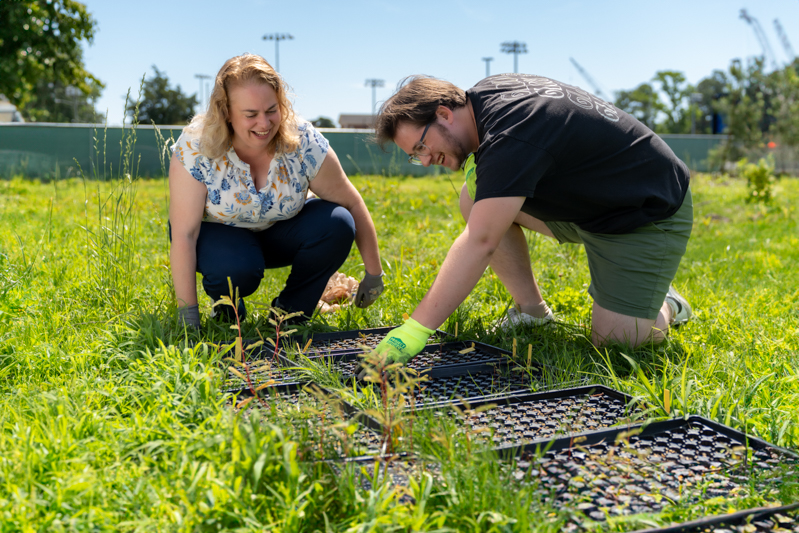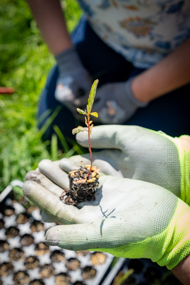
Read time:

You could say Alex Arena’s love of being among plants and digging in the dirt has literally grown like a weed since he arrived as a student at Christopher Newport.
Arena finds joy in watching flora blossom. You could even say he likes to get to the root of the botanical world, sowing seeds of knowledge that will expand his understanding.
So, when CNU recently established a campus garden located off of Prince Drew Road near TowneBank Stadium for student and faculty research, he was thrilled. A garden space was exactly what he had hoped for to conduct successful experiments and, in turn, nurture his curiosity and propel his quest for answers.
“I was ecstatic,” Arena said. “There isn’t a lot of space for us botanists on campus, so having a research garden helps so much.”
The newly developed garden space will serve as a living lab for professors and students. The garden will elevate research opportunities across campus, allowing students to take their learning out of the classroom and into the field, so to speak. It is the first garden on campus geared toward research. A community garden on East Campus is available for the planting of vegetables and flowers.
For many years, CNU facilities for botanical research consisted of growing beds in growth chambers that were located in Forbes Hall. The outside garden adds a much-needed dimension to plant research.
Arena, ‘24 Environmental Biology, is in the five-year bachelor’s-to-master’s program in Environmental Science. He is working on his thesis project, and the garden will play a key role in helping him achieve the results he is cultivating through his efforts.
Arena’s experiment, which is focused on the effects of urbanization on plant life, will be the garden’s inaugural project. He will soon plant partridge pea, a hearty plant, in the CNU garden and at various places throughout Newport News. He will then compare how the different urban environments impacted its health. The project will shed light on how plants prosper in spaces that possess different attributes. For example, does a plant thrive just as well growing in a sidewalk crack as it does in a forest?
“This research garden gives me the perfect planting spot for the thesis research,” Arena said. “The garden has already helped me to achieve my goals by giving me a protected space outside in which I can grow my plants with no worry of human or animal interference.”
The garden’s location was pinpointed and prepared by the Grounds Department, which fenced the area and also ensured there was city water accessible on site. In the near future, the garden space will be tilled to prepare for planting.
The plans for the garden are constantly changing and expanding, with different faculty hatching ideas of what can be planted to support their research and how it can best provide a hands-on learning location for their students.
“It’s a great way to engage students in the process,” said Janet Steven, associate professor in the Department of Organismal and Environmental Biology. “There are so many opportunities, and we are so excited about what we can do with it.”
Looking around the garden one afternoon, Steven, who teaches classes on plants, evolution, conversation and experimental methods, took inventory of the growth in the garden, mostly weeds at this point.
She quickly reeled off a list of possible research projects for which all the different plants could be utilized, including exploring how certain plants extract metals out of the ground, a possible way to clean soil that has been saturated with toxic chemicals.
Faculty are currently exploring options for the garden. A chemistry professor who has worked with students on studying beer and developing a process to sharpen flavors, is considering planting hops to further his research.
“I am excited because the space will provide opportunities for our faculty to engage in research with students in a different way,” said Dr. Nicole Guajardo, Dean of the College of Natural and Behavioral Sciences. “They will be able to explore new questions and expand the work that has been previously possible.”
Eventually, she said, there are plans to add a greenhouse to the garden space.
Dr. Ted Primka, an assistant professor in the Department of Organismal and Environmental Biology, said the garden holds a huge amount of potential in terms of learning and research. He intends on not only using it for his classes as a learning hub, but also for research he is conducting on flooding effects, which tests theories on fine root dynamics. Primka anticipates the garden will be utilized in many ways, including for research collaboration among professors and as an outdoor space in which students can see in real time what they are learning in the classroom about botany.
“The garden is important because it is a space for research that is accessible to all students on campus,” Primka said. “Before the establishment of the garden, there was no place for plant research to be conducted outdoors in soil on campus at CNU.”